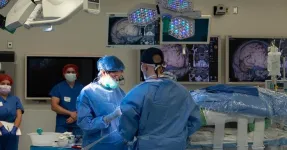(Press-News.org) Esophageal adenocarcinoma (EAC) is a highly lethal cancer, with a five-year survival rate of less than 20 percent. Although a precursor lesion to EAC, called Barrett's esophagus (BE), is present in roughly seven percent of middle-aged adults, less than one percent of BE patients will progress to EAC, making it difficult to determine which individuals are at risk of developing this deadly cancer. To better understand why only a small fraction of individuals with BE develop EAC, investigators from the Mass General Cancer Center, a member of the Mass General Brigham healthcare system, used genomic databases to identify genetic drivers associated with EAC. Their results, published in Gastroenterology, highlight that nine percent of EAC patients harbor mutations in cancer-predisposing genes, shedding light on the causes of progression to the disease and new possibilities for screening and treatment.
“The development of EAC was previously thought of as a ‘bad luck’ phenomenon, so we were stunned to find cancer-predisposing mutations in esophageal cancer patients at such a high rate,” said corresponding author Manish Gala, MD, of the Division of Gastroenterology at Massachusetts General Hospital (MGH). “To put that into perspective, the prevalence of such mutations is seven to 10 percent in pancreatic adenocarcinoma, and genetic testing has been recommended for all individuals diagnosed with this cancer. Given the similar prevalence in EAC, universal genetic testing should be considered for this cancer as well.”
Notably, the researchers found that EAC patients with cancer-predisposing mutations had developed EAC across the age spectrum, implying that simply having a mutation did not trigger EAC; rather, BE and other environmental factors are likely additional prerequisites for cancer. Still, findings suggest that these “germline” cancer-predisposing mutations, which are present at conception and therefore found in every cell of a patient, may accelerate genomic instability that increases the likelihood of progression from BE to EAC.
This study was based on genomic data from 640 individuals with EAC, pooled from public U.S. and U.K. databases. Fifty-nine patients had highly rare, cancer-predisposing germline mutations, most commonly in the ATM gene. To validate these results, the researchers also analyzed nearly 300 individuals from MGH cohorts who either had EAC or BE with high-grade dysplasia (a precursor to EAC), BE without cancer progression after 10 or more years, or who were healthy nonagenarians. Again, they found that germline mutations, especially in the ATM gene, were the most prevalent in EAC patients, with evidence that in people who progressed to EAC, there may be additional epigenetic changes that cause abnormalities in ATM expression compared to non-progressors.
Results from the study also shed light on the existing question of why approximately 30% of EAC patients do not have a common cancer-causing mutation, a TP53 mutation, within their tumor cells. The researchers found that EAC patients without TP53 mutations in their tumors were instead much more likely to have pathogenic germline mutations, and at a rate comparable to that of ovarian cancer, which is known to be a highly genetics-dependent disease. Collectively, results support the idea that genetic testing can help risk-stratify EAC patients, due to the important role germline mutations appear to play in triggering progression from BE to EAC.
Going forward, the researchers plan to derive estimates of EAC risk based on gene-specific mutations, a task that will require larger study cohorts. Furthermore, they are using their knowledge of the germline mutations common in EAC (such as ATM mutations) to repurpose existing therapies that may be useful for treating EAC, with two drug candidates already identified.
“The key takeaway from this study is that if someone is progressing toward EAC from BE, performing genetic testing is probably warranted,” Gala said. “For people who already know they have a mutation, we will still need more data to figure out how to best care for these individuals, but a one-size-fits-all approach to screening may not be appropriate.”
Disclosures: None relevant
Funding: The study was funded by grants from the Elsa U. Pardee Foundation, American College of Gastroenterology, and the National Institutes of Health.
Paper cited: Lee, M et al. “Germline Determinants of Esophageal Adenocarcinoma” Gastroenterology DOI: 10.1053/j.gastro.2023.07.015
###
About Mass General Brigham
Mass General Brigham is an integrated academic health care system, uniting great minds to solve the hardest problems in medicine for our communities and the world. Mass General Brigham connects a full continuum of care across a system of academic medical centers, community and specialty hospitals, a health insurance plan, physician networks, community health centers, home care, and long-term care services. Mass General Brigham is a nonprofit organization committed to patient care, research, teaching, and service to the community. In addition, Mass General Brigham is one of the nation’s leading biomedical research organizations with several Harvard Medical School teaching hospitals. For more information, please visit massgeneralbrigham.org.
END
Royal colleges in the UK have received more than £9 million in marketing payments from drug and medical devices companies since 2015, but do not always disclose the payments publicly, finds an investigation published by The BMJ today.
Investigative journalist Hristio Boytchev asked the colleges to disclose all payments from industry, campaign groups or patient associations, including the specific amount received from each donor, but they all refused to do so.
Instead, data was compiled from Disclosure ...
Pupils in state secondary schools in England are much more likely to be excluded if they have a history of receiving social care or special educational needs services, finds a new study by UCL researchers.
The research, published in Child Abuse and Neglect, used anonymised data from the Department for Education’s National Population Database, which covered all children starting state secondary school in September 2011 and 2012 across the country – equating to around one million students.
The team examined the proportion of pupils who had been excluded – either temporarily suspended or permanently expelled – during their time at secondary ...
In what could lead to a revolutionary advancement in the treatment of temporal lobe epilepsy, UC San Diego Health has become one of the first health systems in the country to inject regenerative cells into the brain to treat epileptic seizures.
Part of a national clinical trial, UC San Diego Health’s multidisciplinary team performed the third ever experimental regenerative brain cell therapy procedure earlier this month. UC San Diego Health is the only nationally designated Level 4 Adult Epilepsy Center in the region.
During the surgery, Sharona ...
FOR IMMEDIATE RELEASE ON WEDNESDAY, JULY 26, 2023
AAN Issues Guidance on New Treatments for Early Alzheimer’s Disease
MINNEAPOLIS – New therapies for early Alzheimer’s disease, monoclonal antibodies that remove amyloid-β plaques in the brain, are bringing hope to people whose lives have been affected by the disease. To help neurologists discuss these therapies with patients and caregivers, the American Academy of Neurology has developed an Emerging Issues in Neurology article, published online on July 26, 2023, in Neurology®, the medical journal of the American Academy of Neurology. Emerging Issues in Neurology articles are designed ...
Many families whose transgender children need gender-affirming care will need to drive much further than before because of laws and other actions passed since 2021 in 20 states, a new study shows.
The restrictions mean that 25% of Americans age 10 to 17 now live more than a day’s drive away, round trip, from a clinic that could provide medications and hormones to support their gender transition. Before the restrictions, less than 2% lived this far from a clinic that could provide such care.
One ...
Researchers from MIT and Stanford University have devised a new machine-learning approach that could be used to control a robot, such as a drone or autonomous vehicle, more effectively and efficiently in dynamic environments where conditions can change rapidly.
This technique could help an autonomous vehicle learn to compensate for slippery road conditions to avoid going into a skid, allow a robotic free-flyer to tow different objects in space, or enable a drone to closely follow a downhill skier despite being buffeted by strong winds.
The researchers’ approach incorporates certain structure from control theory into the process for learning a model in such a way that leads ...
LAS VEGAS – July 26, 2023 – Black holes are the most mysterious objects in the universe, with features that sound like they come straight from a sci-fi movie.
Stellar-mass black holes with masses of roughly 10 suns, for example, reveal their existence by eating materials from their companion stars. And in some instances, supermassive black holes accumulate at the center of some galaxies to form bright compact regions known as quasars with masses equal to millions to billions of our sun. A subset of accreting stellar-mass black holes that can launch jets of highly magnetized plasma are called microquasars.
An international ...
Increased skin cancer screening in individuals with skin of color is not sufficient to address racial disparities in melanoma survival rates, according to a new JAMA Dermatology study by UPMC and University of Pittsburgh researchers.
Melanoma causes the most deaths of any skin cancer, but is usually treatable if caught early. Although the disease is most common in white individuals, survival odds are worse in people with darker skin tones.
“In this study, we asked whether screening could address this disparity by helping detect melanoma early,” said senior author Laura Ferris, M.D., Ph.D., dermatologist at UPMC and professor of dermatology at the Pitt School of Medicine. ...
American Geophysical Union
25 July 2023
AGU Release No. 23-29
For Immediate Release
This press release and accompanying multimedia are available online at:
https://news.agu.org/press-release/petrified-trees-reveal-yellowstone-geysers-ongoing-battle-with-drought/
AGU press contact:
Liza Lester, +1 (202) 777-7494, news@agu.org (UTC-4 hours)
Contact information for the researchers:
Shaul Hurwitz, U.S. Geological Survey, shaulh@usgs.gov (UTC-7 hours)
WASHINGTON — Yellowstone’s Steamboat Geyser has had decades-long dry spells brought on by a history of droughts, a new study finds. With global temperatures on the rise, the American West is projected to become drier. ...
https://www.massgeneral.org/news/research-spotlight/lab-on-chip-technology-red-blood-cellsZiya Isiksacan, PhD, a research fellow in the Center for Engineering in Medicine and Surgery (CEMS) is the lead author, and Osman Berk Usta, PhD, an investigator in the CEMS at Massachusetts General Hospital and an associate professor of Surgery at Harvard Medical School, is the senior author of a new study published in PNAS, Assessment of Stored Red Blood Cells Through Lab-on-a-Chip Technologies for Precision Transfusion Medicine.
The article is a collaboration between multiple international institutes ...



